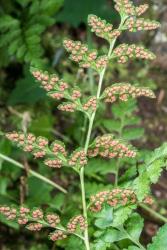Terrestrial ferns. Rhizomes short-creeping (NZ) or rarely erect (not NZ), scaly. Rhizome scales non-clathrate, narrowly ovate. Stipes adaxially sulcate, glabrous or scaly. Laminae 1–3-pinnate (NZ) or 3-pinnate-pinnatifid (not NZ), herbaceous, glabrous or scaly or occasionally bearing minute glandular hairs, rarely bulbiferous (not NZ). Sori round; receptacles raised and hardened. Indusia attached at base, inflated and curving hood-like over the sporangia. Spores monolete, perispores echinate (NZ) or verrucate (not NZ).
A genus of c. 26 species (PPG 1 2016).
Within Cystopteridaceae Cystopteris and Acystopteris are sister genera, and in turn are sister to Gymnocarpium (Rothfels et al. 2012). Cystopteris is distinguished from Gymnocarpium by its lack of articulate pinnae, the presence of indusia, a raised and hardened soral receptacle, and a base chromosome number of x = 42. By contrast Gymnocarpium has articulate pinnae, is exindusiate, has a flat receptacle, and has a chromosome number of x = 40. Acystopteris is distinguished by its multiseptate hairs on the lamina and densely verrucose spores.
Allan (1961) treated Cystopteris in Athyriaceae, which he said included "a few genera of rather uncertain delimitation". Cystopteris was monographed by Blasdell (1963), but he failed to make any mention of the Australasian species C. tasmanica. His work has therefore been largely ignored in the southern hemisphere, and this has contributed to a poor understanding of the genus in New Zealand until relatively recently.
Cystopteris tasmanica was first described by Hooker (1844–1846) from Tasmania, and then reduced to a variety of C. fragilis by Hooker (1858–1859). However, the taxon was not detected in New Zealand until Hooker (1867) included it in his Handbook as C. fragilis. This treatment was followed by Cheeseman (1906, 1925), who added C. tasmanica, C. novae-zealandiae J.B.Armstr., and C. laciniatus Colenso to the synonymy. Allan (1961) also referred New Zealand material to C. fragilis, but suggested that some forms approached C. tasmanica. Blasdell (1963) apparently overlooked C. tasmanica and referred South American and Australasian material to C. fragilis var. apiiformis (Gand.) C.Chr., based on C. apiiformis Gand. from the Falkland Islands. Whether or not South American and Australasian material is identical remains to be determined, but the names C. tasmanica and C. fragilis var. tasmanica have priority over C. apiiformis and C. fragilis var. apiiformis when applied to Australasian material. Lovis (1959) was the first to recognise that both Australian and New Zealand material was sufficiently distinct to warrant species status using the name C. tasmanica.
An adventive plant is now well established in New Zealand. This is referable to the European C. fragilis (Brownsey in Webb et al. 1988), and the presence of both species in New Zealand emphasises their distinctiveness. Colenso’s C. laciniatus is based on the European plant, indicating that it has been here for well over a hundred years.
| 1 | Laminae usually 1–2-pinnate, 20–245 mm long, 8–88 mm wide; fertile and sterile fronds slightly dimorphic; primary pinnae 4–45 mm long, 4–24 mm wide; apices of primary and secondary pinnae obtuse or round-ended | tasmanica |
| Laminae 2–3-pinnnate, 75–280 mm long, 26–175 mm wide; fertile and sterile fronds monomorphic; primary pinnae 16–95 mm long, 9–50 mm wide; apices of primary and secondary pinnae acute or acuminate | fragilis |
In New Zealand, species of Cystopteris can be distinguished by their herbaceous and usually glabrous 1–3-pinnate laminae, characteristically hood-like indusia which enclose the sori, and echinate spores (Large & Braggins 1991).
Cystopteris occurs mostly in temperate regions and often in montane habitats (Rothfels et al. 2012); the majority of species are in the northern hemisphere, with two in South America (Zuloaga et al. 2008) and South Africa (Roux 2009), one endemic to Hawai‘i (Palmer 2003) and one in Australia (Jones 1998). Two species in New Zealand; one native and one naturalised.
| Category | Number |
|---|---|
| Indigenous (Non-endemic) | 1 |
| Exotic: Fully Naturalised | 1 |
| Total | 2 |
The base chromosome number in Cystopteris is x = 42 (Kramer 1990).




